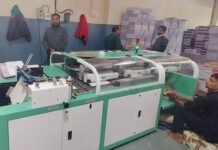Mimaki, which was one of the pioneers in printing to textiles, has introduced its first direct-to-film printer, the TxF150-75, for textile applications.
There have been quite a few DtF printers introduced in the last couple of years, and this approach offers an alternative to printing direct-to-garment or via dye sublimation. The method involves first printing the design to a transfer film, and then sprinkling a hot melt powder onto the film.
This is then heated and dried to create a transferable ink layer on the film. Finally, the film and garment are placed in a heat press to force the ink onto the fabric. It has the advantage of working with a wide range of fabrics but the ink does sit on the surface instead of penetrating into the fabric, which affects the handling of the material. It’s typically used for items such as t-shirts but really comes into its own with less obvious objects such as umbrellas.
The TxF150-75 is based on Mimaki’s existing 150 series wide format printers. It has a maximum printing width of 80cm, with five colors – CMYK plus white – with a circulation system for the white ink. The printer uses a piezo printhead with resolution up to 1440 dpi, which suggests its using an Epson head. It’s fitted with Mimaki’s proven nozzle check unit and nozzle recovery system.
Alongside the printer, there’s a new water-based PHT50 heat transfer pigment ink. This is supplied in 600ml aluminium packs for the colors and 500ml for the white ink, both with built-in degassing. This ink should gain its Oeko-Tex Eco passport certification in March.
Mark Sollman, senior product manager for Mimaki Europe, commented, “Apparel decoration is a hugely popular and dynamic sector, one which we are already operating in with our other textile technologies. However, we could see the impact DTF technology has had on the industry in recent years, with its significant advantages over existing technologies. Namely, DTF avoids the time intensive process of plate creation in screen printing and the required weeding in traditional vinyl heat transfer. The technology can also create vibrant designs with its full color printing capabilities. We’re excited to bring a solution to the market that is designed for those already active in the decorated apparel sector and those looking to enter it, which excels in usability, reliability and quality.”
Mimaki’s offering consists of the printer with its ink, plus a server with the RasterLink 7 RIP software. Customers, or more likely their dealers, will still have to source the hot melt powder, the oven drying machine and the heat transfer press. The TxF150-75 should be available from April this year. You can find further details from mimaki.com.
Republished by permission from www.nessancleary.co.uk












